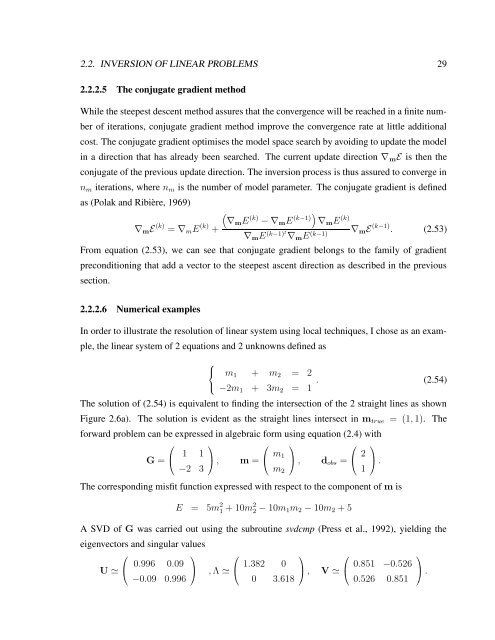Sirgue, Laurent, 2003. Inversion de la forme d'onde dans le ...
Sirgue, Laurent, 2003. Inversion de la forme d'onde dans le ...
Sirgue, Laurent, 2003. Inversion de la forme d'onde dans le ...
Create successful ePaper yourself
Turn your PDF publications into a flip-book with our unique Google optimized e-Paper software.
2.2. INVERSION OF LINEAR PROBLEMS 29<br />
2.2.2.5 The conjugate gradient method<br />
Whi<strong>le</strong> the steepest <strong>de</strong>scent method assures that the convergence will be reached in a finite number<br />
of iterations, conjugate gradient method improve the convergence rate at litt<strong>le</strong> additional<br />
cost. The conjugate gradient optimises the mo<strong>de</strong>l space search by avoiding to update the mo<strong>de</strong>l<br />
in a direction that has already been searched. The current update direction ∇ m E is then the<br />
conjugate of the previous update direction. The inversion process is thus assured to converge in<br />
n m iterations, where n m is the number of mo<strong>de</strong>l parameter. The conjugate gradient is <strong>de</strong>fined<br />
as (Po<strong>la</strong>k and Ribière, 1969)<br />
(<br />
∇m E (k) − ∇<br />
∇ m E (k) = ∇ m E (k) m E (k−1)) ∇ m E (k)<br />
+<br />
∇<br />
∇ m E (k−1)t ∇ m E (k−1) m E (k−1) . (2.53)<br />
From equation (2.53), we can see that conjugate gradient belongs to the family of gradient<br />
preconditioning that add a vector to the steepest ascent direction as <strong>de</strong>scribed in the previous<br />
section.<br />
2.2.2.6 Numerical examp<strong>le</strong>s<br />
In or<strong>de</strong>r to illustrate the resolution of linear system using local techniques, I chose as an examp<strong>le</strong>,<br />
the linear system of 2 equations and 2 unknowns <strong>de</strong>fined as<br />
⎧<br />
⎨<br />
⎩<br />
m 1 + m 2 = 2<br />
−2m 1 + 3m 2 = 1 . (2.54)<br />
The solution of (2.54) is equiva<strong>le</strong>nt to finding the intersection of the 2 straight lines as shown<br />
Figure 2.6a). The solution is evi<strong>de</strong>nt as the straight lines intersect in m true<br />
forward prob<strong>le</strong>m can be expressed in algebraic form using equation (2.4) with<br />
⎛<br />
G = ⎝ 1 1<br />
⎞<br />
⎛<br />
⎠ , m = ⎝ m ⎞<br />
⎛<br />
1<br />
⎠ , d obs = ⎝ 2 ⎞<br />
⎠ .<br />
−2 3<br />
m 2 1<br />
The corresponding misfit function expressed with respect to the component of m is<br />
E = 5m 2 1 + 10m2 2 − 10m 1m 2 − 10m 2 + 5<br />
= (1, 1). The<br />
A SVD of G was carried out using the subroutine svdcmp (Press et al., 1992), yielding the<br />
eigenvectors and singu<strong>la</strong>r values<br />
⎛<br />
⎞ ⎛<br />
0.996 0.09<br />
U ≃ ⎝ ⎠ , Λ ≃ ⎝ 1.382 0<br />
⎞<br />
⎠ ,<br />
−0.09 0.996<br />
0 3.618<br />
⎛<br />
⎞<br />
0.851 −0.526<br />
V ≃ ⎝ ⎠ .<br />
0.526 0.851

















